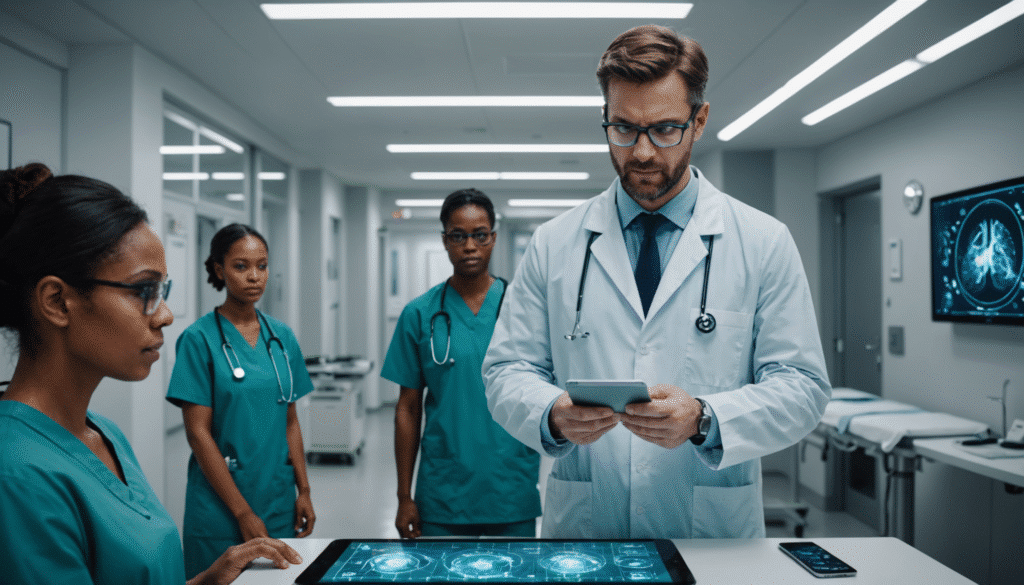L’integration of the digital health technologies in the practice of general medicine marks a significant evolution in the way care is provided. These advances provide doctors with innovative tools to respond more effectively to patient needs. Despite this development, adoption of new technologies remains uneven, with some platforms and tools remaining underutilized. The impact of digital tools on doctor-patient relationship and on the quality of care is undeniable, paving the way for a more personalized and proactive approach to health.

The integration of digital health technologies in the practice of general medicine represents a major transformation that profoundly changes the way health care is administered. This evolution is accompanied by various technological advances, ranging from mobile apps to connected medical devices, including Artificial Intelligence (AI) and health information systems. Each of these innovations aims to improve the efficiency of care, optimize patient care and facilitate access to medical information. However, their adoption is not without challenges.
The first step in the integration of digital technologies lies in their adoption by healthcare professionals. Although many digital platforms are available to assist doctors, several obstacles persist when it comes to their daily use. Indeed, despite a growing interest in e-health, many practitioners remain reluctant to use it, often due to a lack of proper training or insufficient understanding of the tools available.
One notable innovation is the incorporation ofAI algorithms into the diagnostic and treatment process. These algorithms are designed to analyze large amounts of medical data and provide recommendations based on predictive models. This allows physicians to make informed, evidence-based decisions while reducing the margins of error. However, resistance to AI adoption can be attributed to concerns about the transparency, security, and accuracy of the data used by these systems.
At the same time, the development of electronic medical records (EMRs) is a key element of this digital transition. EMRs facilitate the updating and rapid access to patients’ medical information, thus ensuring continuity of care. With data centralized, it becomes easier for physicians to diagnose conditions, analyze medical histories, and collaborate with other healthcare professionals. However, implementing EMRs poses challenges in terms of data security and training employees to use these systems.
The integration of digital technologies is not limited to medical records management. Connected medical devices, such as smartwatches and health sensors, allow patients to monitor their health in real time. These tools can measure vital parameters such as blood pressure, heart rate, and glucose levels. When paired with health management applications, these devices provide physicians with valuable data to personalize patient care.The
digital health is not limited to data collection. It also involves the analysis of this data in order to extract useful insights to improve medical practices. Innovative approaches, such as the exploitation of digital biomarkers , can help detect diseases like Alzheimer’s at an early stage, which is essential for rapid and effective intervention. However, implementing these strategies requires close collaboration between health experts, scientists and technology professionals.Despite these advances, gaps remain in the integration of digital technologies in general practice. Many doctors report that they do not receive adequate training in the use of technologies and digital tools. Thus, the need for ongoing training and technical support is essential to drive the successful adoption of these new systems. This should also include discussions about ethics and responsibility related to the use of technologies in medical practice.
Another barrier to overcome is the question of
systems synchronization . Interoperability between different tools and databases is crucial to ensure smooth communication between healthcare professionals and patients. Disparate systems can result in loss of critical information and impact quality of care. It is therefore imperative that digital health technologies are developed while ensuring compatibility, so that each actor in the health system can operate synergistically.When it comes to security, protecting patient data is a major concern when integrating digital technologies. Cyberattacks targeting healthcare organizations are on the rise, making data security of paramount importance. Healthcare professionals should be trained on potential risks and strategies to protect sensitive data. This includes protective measures such as information encryption and security incident response protocols.
The consequences of the integration of digital technologies are also perceptible on the doctor-patient relationship. The digitalization of healthcare has made care more accessible through remote consultations via telemedicine platforms. This model offers flexibility for both patients and doctors, while facilitating ongoing monitoring of chronic diseases. However, the digitalization of the medical relationship also raises questions about the
human relationship in care, making it necessary to constantly seek a balance between technology and humanity in medical practice. To meet these challenges and take full advantage of the benefits that digital technologies offer, it is essential that healthcare adopts a multidimensional and collaborative approach. This involves promoting a culture of innovation within healthcare institutions, as well as collaboration between diverse stakeholders, including doctors, technologists, policymakers and patients themselves. Together, these stakeholders can define standards and protocols that ensure that the integration of digital technologies contributes to the continuous improvement of care.
Finally, the evolution towards a truly digital primary care practice will largely depend on the ability of physicians to adapt to changes and adopt innovative solutions. Recent studies show that
collaborative work and the exchange of information between different health professionals are essential elements for success. Sharing best practices and experiences could also foster a wider adoption of technologies in primary care. In conclusion, although challenges and obstacles persist, the integration of digital health technologies in primary care practice should be seen as an opportunity to improve the health and well-being of patients. For further information on these topics, it is interesting to consult resources such as
the digital revolution in health ,the digital modernization of the health system in South Korea and the challenges and innovations of MedTech startups . These articles offer enriching perspectives on current and future trends in health technologies.When it comes to innovative treatment approaches, chronic pain management in primary care is also a hot topic, and you can learn more about it in this article on
Innovative Approaches to Chronic Pain Management .Finally, current issues in
healthcare data security , as well as potential solutions to address them, can be explored inthis brief on health care data security .Learn how the integration of digital health is transforming healthcare, improving access, quality of care, and the patient experience through innovative technologies and connected solutions.

digital health technologies in the practice of general medicine represents a major turning point in the way in which care is provided. These tools offer significant opportunities to improve the effectiveness of treatments, optimize patient monitoring and enrich the overall care experience. However, their adoption requires a well-thought-out strategy adapted to the specific needs of healthcare professionals and patients. Assessment of needs and available tools
Before integrating digital technologies into daily practice, it is imperative to carry out a
in-depth assessment needs. Doctors must identify areas in which digital tools can provide added value, for example, monitoring chronic diseases, managing prescriptions or communicating with patients. It is also essential to explore the different tools available such as mobile apps , health management software and teleconsultation platforms. An in-depth knowledge of the tools will allow practitioners to choose those that best suit their practice.Training and awareness of medical staff
There
training of doctors and health personnel to the use of digital technologies is a crucial issue. Awareness sessions should be held to ensure that all members of the medical team are comfortable with the new tools. This includes not only technical mastery, but also understanding the benefits they can bring to patient care. In addition, the evaluation of feedback is crucial to adjust training to the specific needs identified in the field. Strengthening communication between doctors and patients
Digital technologies facilitate
communication between doctors and their patients. It is recommended to implement tools such as secure messaging platforms that enable rapid and efficient exchange of information. Additionally, webinars and video consultations offer a valuable alternative for patients who are remote or have difficulty traveling. This increased accessibility can not only enrich the doctor-patient relationship, but also strengthen patients’ engagement in their own care journey. Data security and respect for confidentiality
With the integration of
digital technologies , the security of medical data becomes a priority. Doctors must ensure that the tools chosen meet security and confidentiality standards. It is essential to use platforms that guarantee the protection of patients’ personal information. Training on data management and security protocols should also be in place to minimize the risk of data breaches.Monitoring and evaluation of results
The integration of digital technologies also requires a
regular monitoring and an evaluation of the results. Doctors must implement performance indicators to measure the impact of digital tools on the quality of care and the patient experience. This evaluation will make it possible to adjust practices and ensure that the integration of technologies meets the objectives set. Additionally, collecting patient feedback on their experience can provide important insights to continually improve services.












